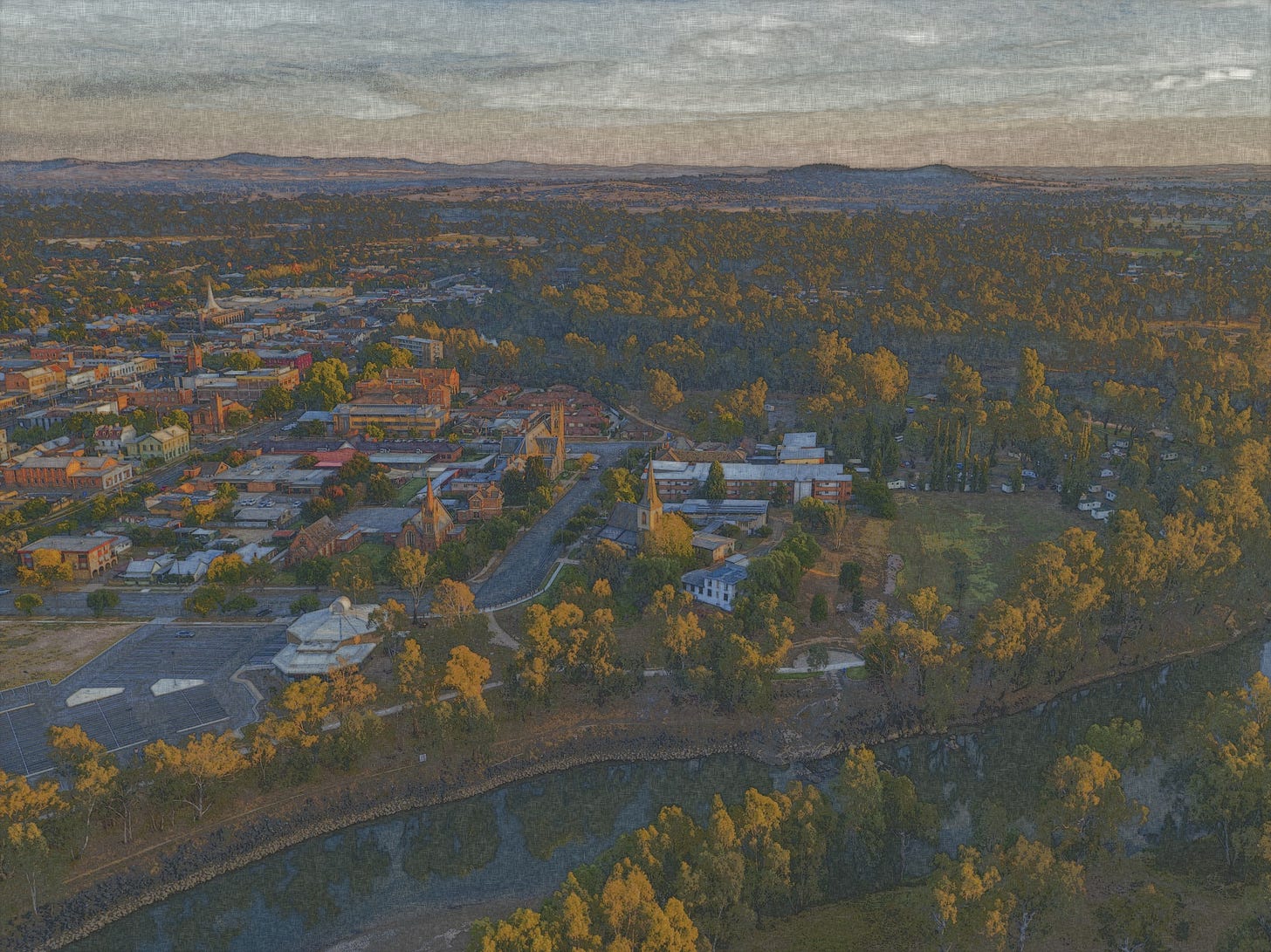Heat, light, and long afternoons do some of the storytelling work in this chapter. What follows is a short, spoiler-light guide to the places, objects, media, and slang that may be unfamiliar if you did not grow up in Australia, so the textures land without needing to pause mid-page.
“He loved that moment, the sudden hush. The paper-smell. The difference.”
Where we are
Wagga Wagga, Riverina, NSW. A major inland city on the Murrumbidgee River. When locals say “the beach,” they mean a sandy river bend called Wagga Beach where people swim in summer. It is minutes from town and part of a larger riverside park.
The river in the room. The Murrumbidgee shapes summer: cicadas, dust, heat glare, and afternoons that drift down to the water. The chapter’s long, quiet walks and the swim spot called “Wagga Beach” fit that rhythm.
Army in the background
Wagga sits beside Kapooka, home to the Army’s recruit training at Blamey Barracks, often called the “Home of the Soldier.” Seeing a father with an Army haircut and a strict bearing by the river is exactly the sort of everyday sight you get in a garrison town.
Everyday places and objects
Milk bar. A corner shop for newspapers, lollies, milkshakes, and basics.
RSL. The Returned and Services League, a veterans’ organisation whose local clubs and halls are part of many towns’ social fabric. Passing “the fence behind the RSL” is a very normal piece of local geography.
Civic Centre and Library. Wagga’s civic precinct includes the city library, the exact sort of cool refuge Christian uses.
The belt on the hook. A small detail with heavy weight in many 1970s homes. Corporal punishment was far more normalised in families and schools than it is now.
Media and soundscape
Johnny Farnham on the radio. “Rock Me Baby” was a 1972 single by the singer then billed as Johnny Farnham, and it would still be spinning on summer radios the following year. Tinny verandas, heat haze, and a familiar chorus are part of the time stamp.
Elvis on the telly. Aloha from Hawaii via Satellite was broadcast live across Asia and Oceania on 14 January 1973, so a family in regional NSW catching it, sound cutting in and out on an old aerial, is right for the month. Australia did not get colour television until 1 March 1975, so Christian’s household would be watching in black and white.
The local paper. The Daily Advertiser is Wagga’s long-running newspaper, the kind of masthead that carries world headlines into a boy’s hands the next morning.
Food, home texture, and tiny rituals
A small jam sponge dusted with icing sugar, a fan that squeaks, linoleum that sticks near the fridge, a flyscreen door that snaps, and a single candle that nobody lights. These are ordinary, recognisable details in an Australian 1970s house, especially in the heat of January when birthdays fall in the school holidays and people are too hot to perform celebration.
Language and school culture
“Bludging.” Australian slang for slacking off or avoiding work, still common. When an adult mutters about “no more bludging” before school starts, that is a familiar growl.
State schools in NSW in 1973 were formal, with strict discipline and whole-school assemblies. Haircuts before term and stationery lists in January are a ritual many readers will recognise, just shifted back a generation.
A mini glossary from the chapter
Milk bar: small neighbourhood shop for snacks, milkshakes, newspapers.
RSL: Returned and Services League, veterans’ organisation with local clubs and halls.
Telly: Television. Used casually for the family set in the lounge.
Git: Mild insult for a foolish or annoying person. Wayne’s throwaway sneer at Elvis.
Wagga Beach: the sandy river bend on the Murrumbidgee where locals swim.
Civic Centre: Wagga’s civic precinct that includes the city library.
Bludging: slacking off, avoiding work or school effort.
The Daily Advertiser: Wagga’s regional newspaper.
Then and now
In 1973, Australian television was still black and white. Colour began nationwide on 1 March 1975.
Road signs and speed limits were still in miles in 1973. Australia switched to kilometres on 1 July 1974, so Christian’s January is pre-metric on the roads.
Questions welcome
If anything still felt unfamiliar, say where you stumbled in the comments, and I will expand this guide so the next reader can ride the current more easily.




